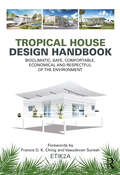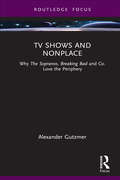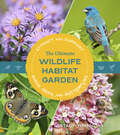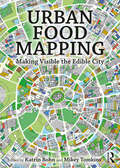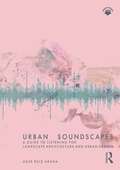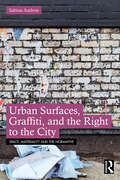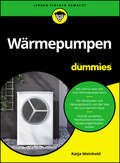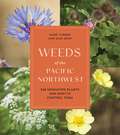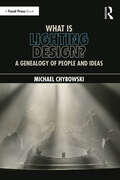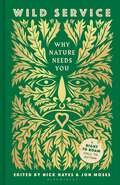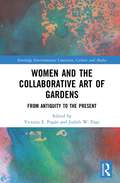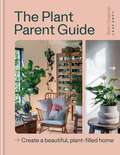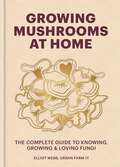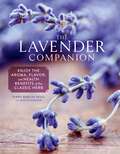- Table View
- List View
Tropical House Design Handbook: Bioclimatic, Safe, Comfortable, Economical and Respectful of the Environment
by Etik2aPacked with accessible information, this book covers all the technical and practical aspects of home design in tropical environments. . It begins by outlining the prerequisites needed to understand the issues involved (climate, heat, thermal comfort, etc.) and discusses the solutions offered by traditional housing. It then identifies current solutions for protecting buildings and their occupants from solar radiation and external heat, while promoting bioclimatic and environmentally friendly approaches. . The economic viability of the solutions identified is discussed, as are the advantages and disadvantages of the materials, depending on the context and standards in force. . Numerous examples illustrate how buildings can be adapted to local realities, from the avant-garde creations of Jean Prouvé to those of today’s architects who are committed to sustainable development, as well as specific projects incorporating the recommendations made in this book. More than 460 photos, drawings, diagrams, tables, maps, house plans, logos and pictograms illustrate this reference work for all those involved in construction in tropical regions, particularly students in the field and, more generally, anyone – from professionals to private individuals – looking for useful information on this subject.
TV Shows and Nonplace: Why The Sopranos, Breaking Bad and Co. Love the Periphery (Routledge Focus on Television Studies)
by Alexander GutzmerThis book scrutinizes the relationship between contemporary TV shows and space, focusing on the ways in which these shows use and narrate specific spatial structures, namely, spaces far away from traditional metropolises. Beginning with the observation that many shows are set in specific spatial settings, referred to in the book as “nonplace territories” – e.g., North Jersey, New Mexico, or rural and suburban Western Germany – the author argues that the link between such nonplace territories and shows such as The Sopranos, Breaking Bad, or Dark is so intense because the narrative structure functions similarly to these territories: flat, decentralized, without any sense of structure or stable hierarchy. The book takes three different perspectives: first, it looks at the rationale for combining TV shows and nonplace territories from the viewpoint of narrative strategy. It then thinks through what these strategies mean for practicing architects. Finally, it approaches the arguments made before from a “user” perspective: what does this narrative mirroring of social-spatial reality in places such as Albuquerque or Jersey City mean for people living in these places? This new approach to architecture and space on screen will interest scholars and students of television studies, screen architecture, media and architectural theory, and popular culture.
TV Shows and Nonplace: Why The Sopranos, Breaking Bad and Co. Love the Periphery (Routledge Focus on Television Studies)
by Alexander GutzmerThis book scrutinizes the relationship between contemporary TV shows and space, focusing on the ways in which these shows use and narrate specific spatial structures, namely, spaces far away from traditional metropolises. Beginning with the observation that many shows are set in specific spatial settings, referred to in the book as “nonplace territories” – e.g., North Jersey, New Mexico, or rural and suburban Western Germany – the author argues that the link between such nonplace territories and shows such as The Sopranos, Breaking Bad, or Dark is so intense because the narrative structure functions similarly to these territories: flat, decentralized, without any sense of structure or stable hierarchy. The book takes three different perspectives: first, it looks at the rationale for combining TV shows and nonplace territories from the viewpoint of narrative strategy. It then thinks through what these strategies mean for practicing architects. Finally, it approaches the arguments made before from a “user” perspective: what does this narrative mirroring of social-spatial reality in places such as Albuquerque or Jersey City mean for people living in these places? This new approach to architecture and space on screen will interest scholars and students of television studies, screen architecture, media and architectural theory, and popular culture.
The Ultimate Wildlife Habitat Garden: Attract and Support Birds, Bees, and Butterflies
by Stacy TornioThis beginner-friendly handbook helps homeowners create a beautiful garden that attracts birds, bees, butterflies, and more. In The Ultimate Wildlife Habitat Garden, Stacy Tornio makes it easy to attract birds, bees, and butterflies to your home garden by sharing details about which plants attract specific creatures. Entice birds with black-eyed susans, attract bumblebees by planting bee balm, and more. Choose from ten garden plans, including a hummingbird garden, a birdseed garden, and options that are low-maintenance and drought-resistant. You&’ll also get advice on finding the right feeder, avoiding pesticides, and choosing native plants. This beautiful, photo-filled guide will enable you to create the earth-friendly garden of your dreams.
Urban Food Mapping: Making Visible the Edible City
by Katrin Bohn Mikey TomkinsWith cities becoming so vast, so entangled and perhaps so critically unsustainable, there is an urgent need for clarity around the subject of how we feed ourselves as an urban species. Urban food mapping becomes the tool to investigate the spatial relationships, gaps, scales and systems that underlie and generate what, where and how we eat, highlighting current and potential ways to (re)connect with our diet, ourselves and our environments.Richly explored, using over 200 mapping images in 25 selected chapters, this book identifies urban food mapping as a distinct activity and area of research that enables a more nuanced way of understanding the multiple issues facing contemporary urbanism and the manyfold roles food spaces play within it. The authors of this multidisciplinary volume extend their approaches to place making, storytelling, in-depth observation and imagining liveable futures and engagement around food systems, thereby providing a comprehensive picture of our daily food flows and intrastructures. Their images and essays combine theoretical, methodological and practical analysis and applications to examine food through innovative map-making that empowers communities and inspires food planning authorities. This first book to systematise urban food mapping showcases and bridges disciplinary boundaries to make theoretical concepts as well as practical experiences and issues accessible and attractive to a wide audience, from the activist to the academic, the professional and the amateur. It will be of interest to those involved in the all-important work around food cultures, food security, urban agriculture, land rights, environmental planning and design who wish to create a more beautiful, equitable and sustainable urban environment.
Urban Food Mapping: Making Visible the Edible City
by Katrin Bohn Mikey TomkinsWith cities becoming so vast, so entangled and perhaps so critically unsustainable, there is an urgent need for clarity around the subject of how we feed ourselves as an urban species. Urban food mapping becomes the tool to investigate the spatial relationships, gaps, scales and systems that underlie and generate what, where and how we eat, highlighting current and potential ways to (re)connect with our diet, ourselves and our environments.Richly explored, using over 200 mapping images in 25 selected chapters, this book identifies urban food mapping as a distinct activity and area of research that enables a more nuanced way of understanding the multiple issues facing contemporary urbanism and the manyfold roles food spaces play within it. The authors of this multidisciplinary volume extend their approaches to place making, storytelling, in-depth observation and imagining liveable futures and engagement around food systems, thereby providing a comprehensive picture of our daily food flows and intrastructures. Their images and essays combine theoretical, methodological and practical analysis and applications to examine food through innovative map-making that empowers communities and inspires food planning authorities. This first book to systematise urban food mapping showcases and bridges disciplinary boundaries to make theoretical concepts as well as practical experiences and issues accessible and attractive to a wide audience, from the activist to the academic, the professional and the amateur. It will be of interest to those involved in the all-important work around food cultures, food security, urban agriculture, land rights, environmental planning and design who wish to create a more beautiful, equitable and sustainable urban environment.
Urban Soundscapes: A Guide to Listening for Landscape Architecture and Urban Design
by Usue Ruiz AranaSound and listening are intrinsically linked to how we experience and engage with places and communities. This guide puts forward a new conceptual framework of embodied affectivity that emphasises listening in urban research and design and advances new ways of knowing and making. The guide invites landscape architects and urban designers to become soundscape architects and offers practical advice on sound and listening applicable to each stage of a design project: from reading the environment to intervening on it.Urban Soundscapes foregrounds listening as an affective mediator between subjects and multispecies environments, and a vehicle to think and conceptualise environmental research and design beyond prevailing visual and human-centred modes. The guide expands landscape architects’ and urban designers’ tools and skills to assess existing soundscapes, predict how those soundscapes will be altered through their designs, consider sound as a creative and active part of the design process and envisage how users might perceive and be affected by those soundscapes as they evolve in time. The volume sits in the interface of research and practice and interweaves theoretical, methodological and creative contributions from acoustic ecology, ecoacoustics, bioacoustics and sound art. Each of the design stages is illustrated through project examples that demonstrate the many advantages of incorporating attentive listening and sound into Landscape Architecture and Urban Design Practice. This book shows how incorporating listening and sounding as part of the design process promotes slow and subtle ways of practice, adds social and ecological value through the reduction of noise pollution and by monitoring the health of habitats, and enables the design of soundscapes that complement the character and design intent of a scheme and elicit joy and wonder.The book will be of interest to practitioners and academics in landscape architecture, and other design and spatial fields such as urban design, architecture, geography and engineering, who play a primary role in the composition of the soundscape.
Urban Soundscapes: A Guide to Listening for Landscape Architecture and Urban Design
by Usue Ruiz AranaSound and listening are intrinsically linked to how we experience and engage with places and communities. This guide puts forward a new conceptual framework of embodied affectivity that emphasises listening in urban research and design and advances new ways of knowing and making. The guide invites landscape architects and urban designers to become soundscape architects and offers practical advice on sound and listening applicable to each stage of a design project: from reading the environment to intervening on it.Urban Soundscapes foregrounds listening as an affective mediator between subjects and multispecies environments, and a vehicle to think and conceptualise environmental research and design beyond prevailing visual and human-centred modes. The guide expands landscape architects’ and urban designers’ tools and skills to assess existing soundscapes, predict how those soundscapes will be altered through their designs, consider sound as a creative and active part of the design process and envisage how users might perceive and be affected by those soundscapes as they evolve in time. The volume sits in the interface of research and practice and interweaves theoretical, methodological and creative contributions from acoustic ecology, ecoacoustics, bioacoustics and sound art. Each of the design stages is illustrated through project examples that demonstrate the many advantages of incorporating attentive listening and sound into Landscape Architecture and Urban Design Practice. This book shows how incorporating listening and sounding as part of the design process promotes slow and subtle ways of practice, adds social and ecological value through the reduction of noise pollution and by monitoring the health of habitats, and enables the design of soundscapes that complement the character and design intent of a scheme and elicit joy and wonder.The book will be of interest to practitioners and academics in landscape architecture, and other design and spatial fields such as urban design, architecture, geography and engineering, who play a primary role in the composition of the soundscape.
Urban Surfaces, Graffiti, and the Right to the City (ISSN)
by Sabina AndronThis landmark book focuses on urban surfaces, on exploring their authorship and management, and on their role in struggles for the right to the city.Graffiti, pristine walls, advertising posters, and municipal signage all compete on city surfaces to establish and imprint their values on our environments. It is the first time that the surfacescapes of our cities are granted the entire attention of a book as material, visual, and legal territories. The book includes a critical history of graffiti and street art as contested surface discourses and argues for surfaces as sites of resistance against private property, neoliberal creativity, and the imposition of urban order. It also proposes a seven-point manual for a semiotics of urban surfaces, laying the ground for a new discipline: surface studies.Page after page and layer after layer, surfaces become porous and political and emerge as key spatial conditions for rethinking and re-practicing urban dwelling and spatial justice. They become what the author terms the surface commons.The book will appeal to a wide readership across the disciplines of urban studies, architectural theory and design, graffiti, street art and public art, criminology, semiotics, visual culture, and urban and legal geography. It will also serve as a tool for city scholars, policy makers, artists, and vandals to disrupt existing imaginaries of order, justice, and visibility in cities.
Urban Surfaces, Graffiti, and the Right to the City (ISSN)
by Sabina AndronThis landmark book focuses on urban surfaces, on exploring their authorship and management, and on their role in struggles for the right to the city.Graffiti, pristine walls, advertising posters, and municipal signage all compete on city surfaces to establish and imprint their values on our environments. It is the first time that the surfacescapes of our cities are granted the entire attention of a book as material, visual, and legal territories. The book includes a critical history of graffiti and street art as contested surface discourses and argues for surfaces as sites of resistance against private property, neoliberal creativity, and the imposition of urban order. It also proposes a seven-point manual for a semiotics of urban surfaces, laying the ground for a new discipline: surface studies.Page after page and layer after layer, surfaces become porous and political and emerge as key spatial conditions for rethinking and re-practicing urban dwelling and spatial justice. They become what the author terms the surface commons.The book will appeal to a wide readership across the disciplines of urban studies, architectural theory and design, graffiti, street art and public art, criminology, semiotics, visual culture, and urban and legal geography. It will also serve as a tool for city scholars, policy makers, artists, and vandals to disrupt existing imaginaries of order, justice, and visibility in cities.
Wärmepumpen für Dummies (Für Dummies)
by Katja WeinholdSie möchten verstehen, wie Wärmepumpen funktionieren, wie Sie sie in Ihr (bestehendes) Heiz- und Kühlsystem optimal integrieren, welche Förderung Sie erhalten und welche Kosten im Falle eines Einbaus auf Sie zukämen? Dann ist dieses Buch wie für Sie gemacht. Es erklärt die Technik leicht verständlich, macht mögliche Kosten transparent und unterstützt Sie so bei der Entscheidungsfindung. Darüber hinaus zeigt es Ihnen ganz konkret, welche Schritte Sie unternehmen müssen, wenn Sie sich für einen Einbau entscheiden.
Weeds of the Pacific Northwest: 368 Unwanted Plants and How to Control Them
by Sami Gray Mark TurnerA comprehensive guide to the most common weeds of the Pacific Northwest, with essential information on their management and eradication Weeds are everywhere. They crowd out valuable agricultural crops, compete with the tomatoes and beans in your vegetable garden, spread rampantly along roadsides, and pop up from the tiniest cracks in sidewalks. In order to manage them, we must first learn how to identify them. Weeds of the Pacific Northwest is a guide to identifying, controlling, and eradicating over 300 species of weeds that gardeners and homeowners are likely to encounter in Northern California, Oregon, Washington, and British Columbia. Though they can all cause trouble, each weed is different. The hundreds of user-friendly photographs and detailed descriptions of each species here ensure that you can spot and treat any weed in your path. As the experts behind this book demonstrate, some plants can be killed by eating them, some by digging, some by smothering, and some only by the judicious application of chemical herbicides—and it is very important for you and your neighbors to know and understand the differences.
What Is Lighting Design?: A Genealogy of People and Ideas
by Michael ChybowskiWhat Is Lighting Design?: A Genealogy of People and Ideas explains what lighting design is by looking at the history of ideas that are a part of this craft and how those ideas developed. Lighting design began in the West with the Renaissance, and each historical period since then has modified how and why light is used in performance, the methods for producing light, and the consensus around what its purpose is. Exploring each lighting design era and the basic components of lighting design, the book discusses how the central ideas of this craft developed over the past 500 years, what today’s lighting designers are concerned with, and how lighting design contributes to performances. This book is designed as a main course text for History of Lighting Design university courses and a supplementary text for and Introduction to Lighting Design, Stagecraft, and Scenography courses. It will also be of interest to directors, choreographers, and working lighting designers who wish to explore the history and meaning of their craft.
What Is Lighting Design?: A Genealogy of People and Ideas
by Michael ChybowskiWhat Is Lighting Design?: A Genealogy of People and Ideas explains what lighting design is by looking at the history of ideas that are a part of this craft and how those ideas developed. Lighting design began in the West with the Renaissance, and each historical period since then has modified how and why light is used in performance, the methods for producing light, and the consensus around what its purpose is. Exploring each lighting design era and the basic components of lighting design, the book discusses how the central ideas of this craft developed over the past 500 years, what today’s lighting designers are concerned with, and how lighting design contributes to performances. This book is designed as a main course text for History of Lighting Design university courses and a supplementary text for and Introduction to Lighting Design, Stagecraft, and Scenography courses. It will also be of interest to directors, choreographers, and working lighting designers who wish to explore the history and meaning of their craft.
Wild Service: Why Nature Needs You
by Nick Hayes'A reckoning with our past and a vision for a new ecological future' Amy-Jane Beer 'Seeks to undo the damage of exclusionary ownership through the transformative power of belonging' Guy Shrubsole In May 2022, the Royal Swedish Academy of Sciences released a paper that measured fourteen European countries on three factors: biodiversity, wellbeing, and nature connectedness. Britain came last in every single category. The findings are clear. We are suffering, and nature is too.Enter 'Wild Service' – a visionary concept crafted by the pioneers of the Right to Roam campaign, which argues that humanity's loss and nature's need are two sides of the same story. Blending science, nature writing and indigenous philosophy, this groundbreaking book calls for mass reconnection to the land and a commitment to its restoration.In Wild Service we meet Britain's new nature defenders: an anarchic cast of guerilla guardians who neither own the places they protect, nor the permission to restore them. Still, they're doing it anyway. This book is a celebration of their spirit and a call for you to join. So, whether you live in the countryside or the city, want to protect your local river or save our native flora, this is your invitation to rediscover the power in participation – the sacred in your service.
Women and the Collaborative Art of Gardens: From Antiquity to the Present (Routledge Environmental Literature, Culture and Media)
Women and the Collaborative Art of Gardens explores the garden and its agency in the history of the built and natural environments, as evidenced in landscape architecture, literature, art, archaeology, history, photography, and film. Throughout the book, each chapter centers the act of collaboration, from garden clubs of the early twentieth century as powerful models of women’s leadership, to the more intimate partnerships between family members, to the delicate relationship between artist and subject. Women emerge in every chapter, whether as gardeners, designers, owners, writers, illustrators, photographers, filmmakers, or subjects, but the contributors to this dynamic collection unseat common assumptions about the role of women in gardens to make manifest the significant ways in which women write themselves into the accounts of garden design, practice, and history. The book reveals the power of gardens to shape human existence, even as humans shape gardens and their representations in a variety of media, including brilliantly illuminated manuscripts, intricately carved architectural spaces, wall paintings, black and white photographs, and wood cuts. Ultimately, the volume reveals that gardens are best apprehended when understood as products of collaboration. The book will be of interest to scholars and students of gardens and culture, ancient Rome, art history, British literature, medieval France, film studies, women’s studies, photography, African American Studies, and landscape architecture.
Women and the Collaborative Art of Gardens: From Antiquity to the Present (Routledge Environmental Literature, Culture and Media)
by Victoria E. Pagán Judith W. PageWomen and the Collaborative Art of Gardens explores the garden and its agency in the history of the built and natural environments, as evidenced in landscape architecture, literature, art, archaeology, history, photography, and film. Throughout the book, each chapter centers the act of collaboration, from garden clubs of the early twentieth century as powerful models of women’s leadership, to the more intimate partnerships between family members, to the delicate relationship between artist and subject. Women emerge in every chapter, whether as gardeners, designers, owners, writers, illustrators, photographers, filmmakers, or subjects, but the contributors to this dynamic collection unseat common assumptions about the role of women in gardens to make manifest the significant ways in which women write themselves into the accounts of garden design, practice, and history. The book reveals the power of gardens to shape human existence, even as humans shape gardens and their representations in a variety of media, including brilliantly illuminated manuscripts, intricately carved architectural spaces, wall paintings, black and white photographs, and wood cuts. Ultimately, the volume reveals that gardens are best apprehended when understood as products of collaboration. The book will be of interest to scholars and students of gardens and culture, ancient Rome, art history, British literature, medieval France, film studies, women’s studies, photography, African American Studies, and landscape architecture.
The Plant Parent Guide: Create a beautiful, plant-filled home
by Beth ChapmanDid you know we spend an average of 90% of our time indoors? With the air-purifying, mind-calming, stress-relieving and productivity-boosting power of houseplants well established, it is time to transform your home with plants.Created by leading houseplant brand Leaf Envy, The Plant Parent Guide is here to reveal the incredible world of houseplants, but also teach you to select, style and care for them in the best way to suit your space.Upgrade your home with perfectly placed greenery by following the bespoke styling guides for every room, from shaded bedrooms to steamy bathrooms. Whether you're looking for the perfect Zoom backdrop or an oasis of calm in a busy kitchen, there are plenty of tips and tricks for choosing the best plants to suit your light, upkeep and styling requirements.Easy-to-follow care guides make becoming a plant parent pro simple, with advice for every season to ensure your plants flourish year-round. For houseplant newbies there are recommendations for the species hardest to kill, while for the already green-fingered there are ideas for more unusual plants to introduce, and instructions for mastering the art of propagation. With The Plant Parent Guide, any home can become a beautiful and thriving plant-filled space.Photography by Taran Wilkhu.
Growing Mushrooms at Home: The Complete Guide to Knowing, Growing and Loving Fungi
by Elliot WebbEverything you need to know to start growing mushrooms at home!Looking for something quick and easy to grow, that doesn't take up much space, and offers numerous health benefits? Then mushrooms are the perfect choice! Growing Mushrooms at Home will take you through all the basics, from key equipment and step-by-step growing guides all the way to how to turn your harvest into teas, coffees and tinctures. These guides can be used for many varieties - including shiitake, lion's mane, wine cap and oyster - and multiple different growing situations, from buckets and bags to outdoor beds and logs.As well as revealing the essential growing know-how, the book explores our long and complex human history with mushrooms and the fascinating ways fungi continues to shape our world. From ancient Aztec rituals and underground tree communication networks to ground-breaking new medicines and organic pesticides, Growing Mushrooms at Home uncovers the weird and wonderful world of mushrooms, and everything they have to offer.
The Lavender Companion: Enjoy the Aroma, Flavor, and Health Benefits of This Classic Herb
by Jessica Dunham Terry Barlin VesciA celebration of lavender featuring stunning photographs; favorite recipes for the kitchen, pantry, and body care products; along with fascinating lore and gardening guidance from a destination lavender farm. Lavender has long been a favorite herb with its amazing, resinous fragrance; calming qualities; and unique flavor for seasoning food. This lavishly photographed celebration of the beloved herb, written by an acclaimed lavender farmer and cooking instructor, is brimming over with inspiration and ideas for bringing the fragrance and flavor of lavender into daily life. The book profiles the most popular lavender varieties and their recommended uses, along with the history, lore, and traditional medicinal uses. More than 40 recipes showcase lavender in delicious dishes from the kitchen as well homemade craft and body products. Tips for success with lavender in the garden complete this perfect gift for every lavender lover.
Start Growing: A Year of Joyful Gardening for Absolute Beginners
by Daisy PayneEasy, budget-friendly, year-round gardening projects for complete beginners, from This Morning’s gardening expert.If you love house plants and you're ready to try something new . . . this is the book for you! Step away from your screen and discover the joys of growing and connecting with nature.Find simple step-by-step projects for every season accompanied by beautiful photography to guide you throughout. Whether you have a windowsill, patio, small patch of grass, allotment or more room to play with, you’ll find projects to suit your space. From growing salad on your windowsill and creating a houseplant haven in your bathroom to growing outdoor fruit and veg or creating a beautiful garden boarder, this book covers all your practical gardening basics and the tools you’ll need to start out with.
